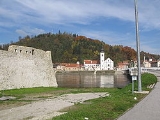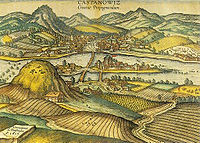
Hrvatska Kostajnica
Encyclopedia
Hrvatska Kostajnica, often just Kostajnica, is a small town in central Croatia
. It is located on the Una river in the Sisak-Moslavina county
, south of Petrinja and Sisak
and across the river from Bosanska Kostajnica
in Bosnia and Herzegovina
.
 Kostajnica was first mentioned in the document by knights templar from 1240. This year is used as official birth year of this historic town.
Kostajnica was first mentioned in the document by knights templar from 1240. This year is used as official birth year of this historic town.
Time of the first settlement is unknown, but town lies on very important Roman roads that were used for transporting salt and cotton. Since Roman roads were merged in the vicinity of the city it is believed that settlement dates much earlier than the first written document known today. Position of town is very similar to the town from old roman documents known as “Oeneum”. Five roman milestones were located in the city dating back to the 3rd century A.D.
During 13th and 14th century Kostajnica became a fortification (kaštel) that was built as a protection against invading Turks
. The owners of the fortification were members of the noble families Lipovečki, Tot, Frankopan
, Benvenjud and finally Zrinski
, so the castle is today known as Zrinski castle
(Stari grad Zrinski in Croatian
). Other forts existing during that period were in the surrounding villages of Komogovina, Svinica, and Prevršac. The Turks invaded Kostajnica in 1556 and it wasn't until 1687 that the town was liberated.
During the early 18th century two schools are opened in the city. One school was operated by Catholic Missionary Church of “St. Antun Padovinski”, while the second schools was run as a Serbian Public School.
Kostajnica is known for its natural springs such as; Varoški Bunar, Mrzlenac, Tekija, Pekinac, Paunovac, Angelovac, and Tutulovac. The most popular spring Tekija has engraved sign (drink brother, potion was given to you by the god’s mercy) “Pi brate iz Božje milosti dat ti je napitak.”
During World War II
Hrvatska Kostajnica was bombed by American forces on May 30, 1944.
Kostajnica suffered greatly during the Croatian War of Independence
. A large part of the Croatian population were expelled or killed by rebel Serbs
in 1991 and the city was incorporated into the Republic of Serbian Krajina
. Houses and buildings belonging to Croats were burned and looted, including the baroque
church, the medieval apothecary, and the eighteenth-century Franciscan
monastery. The only piece of the city's cultural heritage left was the castle by the river built by the Frankopan
s. Kostajnica was put back in Croatian control following military victories by the army in August 1995, and the Croat population expelled slowly began returning.
:
In the 2001 population census, Croats made up 77.02% of the population and Serbs were 15.77%.
Fishing and hunting are very important tourist attractions in the city with some of the best natural habitats found in this part of Europe.
Croatia
Croatia , officially the Republic of Croatia , is a unitary democratic parliamentary republic in Europe at the crossroads of the Mitteleuropa, the Balkans, and the Mediterranean. Its capital and largest city is Zagreb. The country is divided into 20 counties and the city of Zagreb. Croatia covers ...
. It is located on the Una river in the Sisak-Moslavina county
Sisak-Moslavina County
Sisak-Moslavina County is a Croatian county in eastern Central Croatia and southwestern Slavonia. It is named after the city of Sisak and the region Moslavina just across the river Sava. According to 2001 census it is inhabited by 185 thousand people....
, south of Petrinja and Sisak
Sisak
Sisak is a city in central Croatia. The city's population in 2011 was 33,049, with a total of 49,699 in the administrative region and it is also the administrative centre of the Sisak-Moslavina county...
and across the river from Bosanska Kostajnica
Bosanska Kostajnica
Kostajnica, also known as Bosanska Kostajnica , is a town and municipality in northern Bosnia and Herzegovina. The town and municipality are situated in the north-western part of the Republika Srpska entity and northern part of the Bosanska Krajina region. The municipality was created from part of...
in Bosnia and Herzegovina
Bosnia and Herzegovina
Bosnia and Herzegovina , sometimes called Bosnia-Herzegovina or simply Bosnia, is a country in Southern Europe, on the Balkan Peninsula. Bordered by Croatia to the north, west and south, Serbia to the east, and Montenegro to the southeast, Bosnia and Herzegovina is almost landlocked, except for the...
.
History

Time of the first settlement is unknown, but town lies on very important Roman roads that were used for transporting salt and cotton. Since Roman roads were merged in the vicinity of the city it is believed that settlement dates much earlier than the first written document known today. Position of town is very similar to the town from old roman documents known as “Oeneum”. Five roman milestones were located in the city dating back to the 3rd century A.D.
During 13th and 14th century Kostajnica became a fortification (kaštel) that was built as a protection against invading Turks
Ottoman Empire
The Ottoman EmpireIt was usually referred to as the "Ottoman Empire", the "Turkish Empire", the "Ottoman Caliphate" or more commonly "Turkey" by its contemporaries...
. The owners of the fortification were members of the noble families Lipovečki, Tot, Frankopan
Frankopan
The Frankopans are a Croatian noble family. Also called Frankapan, Frangepán in Hungarian, and Frangipani in Italian.The Frankopan family is the leading princely Croatian aristocratic family which dates back to the 12th Century and even earlier to Roman times...
, Benvenjud and finally Zrinski
Zrinski
The Zrinski family was a Croatian noble family, influential during the period in history marked by the Ottoman wars in Europe in the Kingdom of Croatia and Hungary and in the later Austro-Hungarian Empire...
, so the castle is today known as Zrinski castle
Fortress Kastel
Fortress Kastel is a castle in Hrvatska Kostajnica, a town in central Croatia, near the border to Bosnia and Herzegovina.The fortress was built most probably in the 14th century and owned by the members of the noble families Frankopan, Lipovečki, Tot, Benvenjud and finally Zrinski, so it is today...
(Stari grad Zrinski in Croatian
Croatian language
Croatian is the collective name for the standard language and dialects spoken by Croats, principally in Croatia, Bosnia and Herzegovina, the Serbian province of Vojvodina and other neighbouring countries...
). Other forts existing during that period were in the surrounding villages of Komogovina, Svinica, and Prevršac. The Turks invaded Kostajnica in 1556 and it wasn't until 1687 that the town was liberated.
During the early 18th century two schools are opened in the city. One school was operated by Catholic Missionary Church of “St. Antun Padovinski”, while the second schools was run as a Serbian Public School.
Kostajnica is known for its natural springs such as; Varoški Bunar, Mrzlenac, Tekija, Pekinac, Paunovac, Angelovac, and Tutulovac. The most popular spring Tekija has engraved sign (drink brother, potion was given to you by the god’s mercy) “Pi brate iz Božje milosti dat ti je napitak.”
During World War II
World War II
World War II, or the Second World War , was a global conflict lasting from 1939 to 1945, involving most of the world's nations—including all of the great powers—eventually forming two opposing military alliances: the Allies and the Axis...
Hrvatska Kostajnica was bombed by American forces on May 30, 1944.
Kostajnica suffered greatly during the Croatian War of Independence
Croatian War of Independence
The Croatian War of Independence was fought from 1991 to 1995 between forces loyal to the government of Croatia—which had declared independence from the Socialist Federal Republic of Yugoslavia —and the Serb-controlled Yugoslav People's Army and local Serb forces, with the JNA ending its combat...
. A large part of the Croatian population were expelled or killed by rebel Serbs
Serbs
The Serbs are a South Slavic ethnic group of the Balkans and southern Central Europe. Serbs are located mainly in Serbia, Montenegro and Bosnia and Herzegovina, and form a sizable minority in Croatia, the Republic of Macedonia and Slovenia. Likewise, Serbs are an officially recognized minority in...
in 1991 and the city was incorporated into the Republic of Serbian Krajina
Republic of Serbian Krajina
The Republic of Serbian Krajina was a self-proclaimed Serb entity within Croatia. Established in 1991, it was not recognized internationally. It formally existed from 1991 to 1995, having been initiated a year earlier via smaller separatist regions. The name Krajina means "frontier"...
. Houses and buildings belonging to Croats were burned and looted, including the baroque
Baroque
The Baroque is a period and the style that used exaggerated motion and clear, easily interpreted detail to produce drama, tension, exuberance, and grandeur in sculpture, painting, literature, dance, and music...
church, the medieval apothecary, and the eighteenth-century Franciscan
Franciscan
Most Franciscans are members of Roman Catholic religious orders founded by Saint Francis of Assisi. Besides Roman Catholic communities, there are also Old Catholic, Anglican, Lutheran, ecumenical and Non-denominational Franciscan communities....
monastery. The only piece of the city's cultural heritage left was the castle by the river built by the Frankopan
Frankopan
The Frankopans are a Croatian noble family. Also called Frankapan, Frangepán in Hungarian, and Frangipani in Italian.The Frankopan family is the leading princely Croatian aristocratic family which dates back to the 12th Century and even earlier to Roman times...
s. Kostajnica was put back in Croatian control following military victories by the army in August 1995, and the Croat population expelled slowly began returning.
Population
The municipality population of 2,763 is composed of the following settlementsNaselje
Naselje is a settlement in Croatia, usually translated as settlement. It is the smallest unit of Croatian territory. Individual settlements are by and large referred to as selo , while naselje is a statistical and administrative category. The units of local government in Croatia, cities and...
:
- Čukur, population 112
- Hrvatska Kostajnica, population 2,130
- PanjaniPanjaniPanjani is a village in Croatia. It is connected by the D30 highway....
, population 122 - Rausovac, population 26
- Rosulje, population 189
- Selište Kostajničko, population 103
- Utolica, population 68
In the 2001 population census, Croats made up 77.02% of the population and Serbs were 15.77%.
Economy
Today, chief occupations are farming, leather (footwear), textiles plant, printing, and wood processing mill.Fishing and hunting are very important tourist attractions in the city with some of the best natural habitats found in this part of Europe.
Notable people
- Svetozar BoroevićSvetozar BoroevicSvetozar Boroević von Bojna was an Austro-Hungarian field marshal who was described as one of the finest defensive strategists of the First World War....
- Austro-Hungarian Field Marshal - Milislav DemerecMilislav DemerecMilislav Demerec was a Croatian-American geneticist, and the director of the Department of Genetics, Carnegie Institution of Washington [CIW], now Cold Spring Harbor Laboratory from 1941 to 1960, recruiting Barbara McClintock and Alfred Hershey.Demerec was born and raised in Kostajnica...
- geneticist, former director of the Cold Spring Harbor LaboratoryCold Spring Harbor LaboratoryThe Cold Spring Harbor Laboratory is a private, non-profit institution with research programs focusing on cancer, neurobiology, plant genetics, genomics and bioinformatics. The Laboratory has a broad educational mission, including the recently established Watson School of Biological Sciences. It...
External links
- http://www.kostajnica.com/

